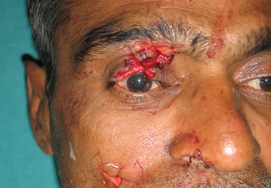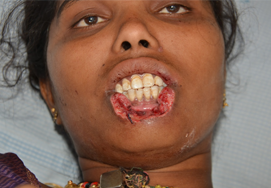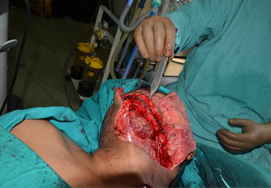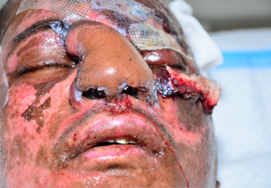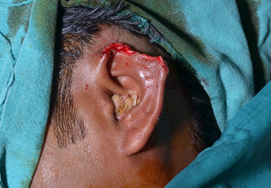Lip And Cheek Reconstruction
Lip reconstruction is performed in individuals who have lip defects due to lip cancer, lip trauma and cleft lip deformity
Cheek reconstruction is performed in individuals who are with congenital, traumatic and Mohs surgery defects, and facial damage due to burns

- How should I prepare for the surgery?
- What is the aftercare of the surgery?
- What are the complications of the surgery?
- What are lip and cheek reconstruction?
- What are the goals of lip reconstruction?
- What are the types of lip reconstruction?
- What are the types of Cheek Reconstruction?
- Which individuals are eligible for the surgery?
How should I prepare for the surgery?
Before the surgery you should,
- Get your blood work up , radiograph, ECG and other general work up done
- Get a preanaesthetic check up done.
- Discontinue aspirin use.
- Avoid large doses of vitamin E.
- Quit smoking and consuming alcohol.
- Take the medication prescribed by your surgeon with sip of water.
What is the aftercare of the surgery?
Certain measures are to be followed after the surgery to reduce the complications, which include:
- Regular cleaning of sutures lines to minimize crust formation
- Minimize tension at the suture sites
- Avoid exposure to sunlight
- Apply antibiotic ointment three times a day
What are the complications of the surgery?
Complications of Lip reconstruction
- Infection
- Lack of oral competence
- Small size of mouth – Microstomia
- Decreased sensation of lips or mouth
- Recurrent disease
- Distal Flap necrosis
Complications of Cheek Construction
- Nerve damage
- Ectropion or lower eyelid edema
- Abnormal hair distribution
- Hematoma
- Distal Flap necrosis
- Asymmetry
- Scarring
What are lip and cheek reconstruction?
Our lips and cheeks are the important facial structures, both for functional and cosmetic reasons. Happiness, sorrow, and every emotion in between are conveyed through this intricate structure. People with abnormalities or defects in their lips and cheeks get invaluable improvement with lip and cheek reconstruction procedures.
Lip reconstruction is required for defects that may result from lip cancer, lip trauma, burns, and cleft lip deformity.
Cheek reconstruction is required for defects that may result from tumors, burns, trauma, whereas congenital abnormalities in cheek contour may be due to facial clefts, vascular anomalies, or facial wasting syndromes.
What are the goals of lip reconstruction?
Lip reconstruction is driven by restoration or preservation of function and aesthetics.
Functional considerations include oral continence, mobility that allows for sound formation and facial expression, adequate oral access, and sensation.
- Oral continence is critical in the ingestion of food and the confinement of salivary fluids within the oral cavity.
- Sound pronunciation- The lips are also essential in pronouncing many sounds, especially those of B, F, M, P, and V.
- Preservation of sensation is preferred both socially and functionally, as insensate lips are more prone to repeat injury.
- Microstomia may become an unavoidable adverse effect in some cases of lip reconstruction, it may cause functional impairment and should be avoided when possible.,
What are the types of lip reconstruction?
Lip defects vary in size and shape, so reconstruction is also determined by its size, shape, quality of surrounding structures
Lower lip reconstruction
If defect is less than 50% then wedge excision and primary closure should be possible
If defect is more than 50% but less than 2/3rd , then the following can be done:
- Karpandzic flap
- Abbes flap for central lip defects
- Estlander flap for defects involving commissure
If defect is 2/3rd of the lower lip or more:
If adequate cheek soft tissue present- Bernard, burrow or websters flap
If inadequate cheek soft tissue is present-
- Regional flaps
- Deltopectoral flap
- Nasolabial flaps
- Free flaps
Upper lip reconstruction
If defect is less than 50%
- In midline then perialar cheek excision advancement flap
- If Laterally then primary closure
If defect is more than 50% but less than 2/3rd then the following can be done:
- Karpandzic flap
- Abbes flap for central lip defects
- Estlander flap for defects involving commissure
If defect is 2/3rd of the upper lip or more :
If adequate cheek soft tissue present
- Modified burrows techinqe
- Nasolabial flaps
If inadequate cheek soft tissue is present
- Regional flaps
- Forehead flap
- Free flaps
What are the types of Cheek Reconstruction?
- Local Flaps: There are two types of flaps and include anterior-based cervicofacial flap and posterior-based cervicofacial flap. The anterior-based cervicofacial flap is used for posterior and moderate-sized anterior defects. The posterior-based cervicofacial flap is used for reconstruction of small and moderate-sized anterior cheek defects.
- Locoregional Flaps: There are two types of flaps and include anterior-based cervicopectoral flap and posterior-based cervicopectoral flap. The anterior-based cervicopectoral flap is used to the larger posterior or lower cheek defects up to 10 cm. The posterior-based cervicopectoral flap is used to reconstruct the large anterior cheek defects.
Regional Flaps: Platysma musculocutaneous flap: This type of regional flaps used to correct head and neck defects.
- Tissue Expanders: These are used adjunct to the utilization of local and locoregional flaps.
- Pedicled Flaps: These are used when the regional tissue is not available. These are also used for the reconstruction of the cheek defects with or without pre-expansion. Supraclavicular flap and deltopectoral flap are the two types of pedicled flaps. The deltopectoral flap is beneficial for the reconstruction of significant cheek defects up to 250 cm2 of the transferable cutaneous tissue.
- Free Flaps: These are the first choice procedure used in the case of composite, complex, and through-through cheek defects with exposed bone, sinuses, orbit or dura.
Prefabricated Flaps: It is mainly used for the reconstruction of complex defects when the conventional techniques are not available.
Which individuals are eligible for the surgery?
Almost all Individuals who have lip defects due to lip cancer, lip trauma and cleft lip deformity are suitable for the lip reconstruction surgery.
Individuals who are with congenital, traumatic and Mohs surgery defects, facial damage due to burns are suitable for the cheek reconstruction surgery.


